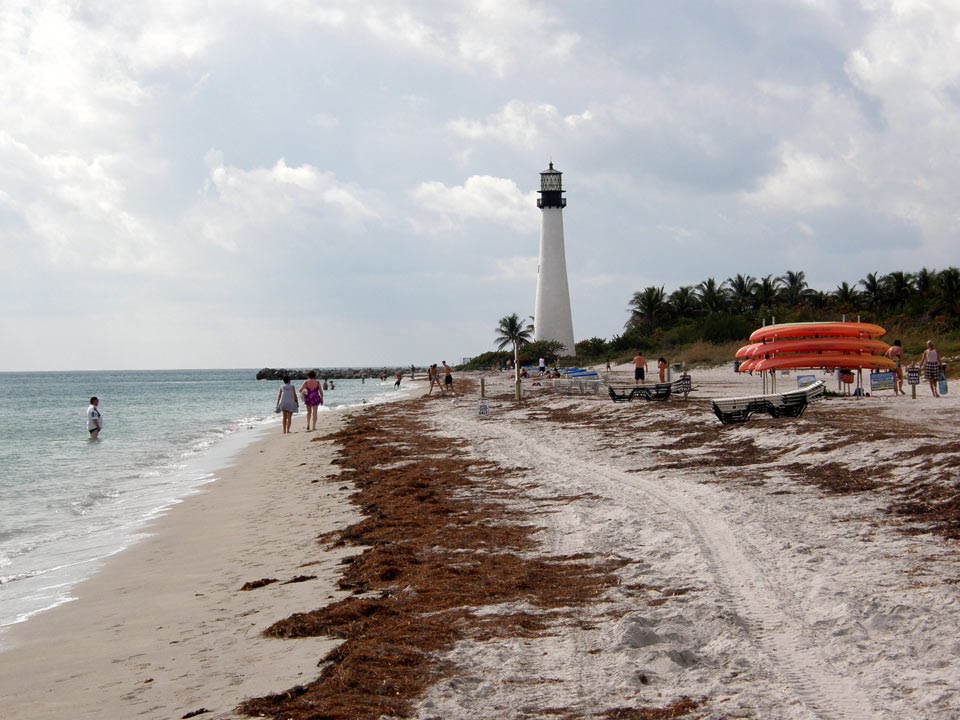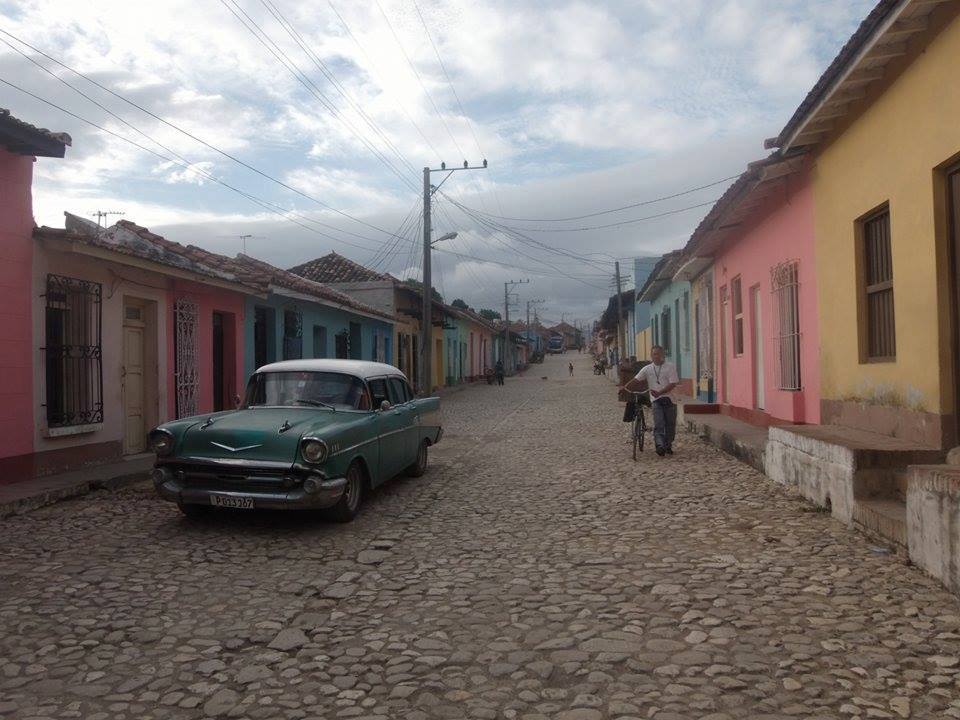In the history of the lighthouse on Cayo Vizcaíno, rebuilt in 1846, in Miami, are braided war stories, with the wars between the Seminole Indians and Americans, the scourge of hurricane, fearsome of comming from Cuba and other parts of the caribbean pirates that raid and often attacked his shores and the romanticism of those who contemplate today lighthouses as vigilantes sea epics.
Solid, brick and white walls whitewashed, 96-foot-tall tower stands firm on the subtropical landscape of the coast and Beach Southeast of Cayo Vizcaíno (Key Biscayne), Florida, surrounded by thick vegetation with palms, ficus and native plants as the grape of Beach (“seagrape”) or mangroves.
The lighthouse at Cape Florida, Miami residents call with the affectionate nickname of “El Farito”, has become a sort of giant Sentinel of this very busy beach weekends by many families with children, who do not conceive the plays in the sand and dives in the sea without the silent presence of the lighthouse.
The Lighthouse is has become in a luck of giant Sentinel of this beach very frequented them end of week by numerous families with children.
The ancient building, is 170 years old, in excellent condition. It is one of the thirty of lighthouses in Florida in use that is better kept and, also, the second oldest in the State, although the original tower, built in 1825, was not as high as the current and had to be restored completely after a voracious fire.
History of the lighthouse Vizcaino
History tells that in July of 1836 had place in it area of Cayo Vizcaíno an of them many skirmishes between the tribe of them Seminole and them forces U.S., almost always as a result of treated fraudulent that were taxes to them Indian for its expulsion of them territories.
Indians attacked the lighthouse was fierce, shot, without the Assistant lighthouse keepers (absent at the time), John Thompson, and a black maintenance, Aaron Carter, could do nothing but entrench themselves with some weapons at the top of the building, while the Seminole group set fire to the door and staircase.
Before the advance of the flames and the heat, them two men not had another alternative that exit to the balcony, where Carter died reached by several shots and Thompson was wounded, although managed to survive to the assault.
“The history of Miami cannot be conceived without this lighthouse, the oldest in South Florida, with a 109 rungs of iron spiral staircase and, although not operating, is in perfect condition and works”, he told Efe Jorge Bustamante, the guide of the lighthouse.
“The history of Miami cannot be conceived without this lighthouse, the oldest in South Florida, with a 109 rungs of iron spiral staircase and, although not operating, is in perfect condition and works”
Bustamante explained that, after the fire, he fell into obscurity and had to pass a decade until, in 1846, the current Tower, high, also of brick, but modified completely in its structure, with four feet thick at the base (the previous thicker era) and interior wrought iron stair walls be lifted.
In the lighthouse “service record” it shows have been one of the first lighthouses, commissioned by the United States Congress after the annexation of Florida in 1821 (until then part of the Spanish territory). A project which, after overcoming difficulties and setbacks, materialized in 1925 under the supervision of engineer Noah Humphreys.
It retains the name of the first lighthouse keeper who dealt with the light installation, maintenance and cleaning of the building and its wooden staircase: John Dubose, married and father of five children, who, shortly after moving to Lighthouse, began to complain and bemoan the isolation in which he lived, “as in any other U.S. Coast” is conceived, wrote in a letter.
If the lighthouse suffered enormous damage during the second Seminole War, and ceased to operate in 1875, the scourge of Hurricane Andrew in August 1992, swept away much of the beautiful natural enclave and let the Tower inoperable and in need of costly repairs.
By fortune, stressed Bustamante, the State went to the rescue of the building e invested in 1996 more than one million of dollars for its complete restoration.
If the lighthouse suffered enormous damage during the second Seminole War, and ceased to operate in 1875, the scourge of Hurricane Andrew in August 1992, swept away much of the beautiful natural enclave.
To the view, the beautiful balcony in it high, the inside Spartan of the lighthouse, with a singular staircase of snail of iron black, without anchors to the wall, that amounts to the fourth of them lenses framed by multiple windows geometric.
The Lighthouse is a viewpoint as there are few in the coast of the South of Florida. This island of Cayo Vizcaíno overlooks a long line of beach dotted with umbrellas, tents and bathers, and a deep sea otearon daily, without a doubt, eight keepers who lived between 1825 and 1878 view of Gull.
Some coasts and reefs that were during centuries refuge and field of action of pirates, between them more feared Black César, a Corsair black that at the beginning of the century 18th found in these islets an area perfect for hide is after the looting and, according to has the legend, bury some of their substantial booties.
Agencies / 14ymedio, La Habana, Emilio J. López/Internet Photos/Arnold Varona/TheCubanHistory.com
THE CUBAN HISTORY, HOLLYWOOD.
![]() EL “FARITO” DEL CAYO VIZCAÍNO EN LA FLORIDA.
EL “FARITO” DEL CAYO VIZCAÍNO EN LA FLORIDA.
En la historia del faro de Cayo Vizcaíno, reconstruido en 1846, en Miami, se trenzan relatos bélicos, con las guerras entre los indios seminolas y los estadounidenses, el azote de huracanes, la incursión de temibles piratas que proveniente de Cuba y otros lugares del Caribe atacaban sus costas y el romanticismo de quienes contemplan hoy los faros como épicos vigilantes del mar.
Sólida, de ladrillo y muros blancos encalados, la torre de 96 pies de altura se alza firme sobre el paraje subtropical de la costa y playa del sureste de Cayo Vizcaíno (Key Biscayne), Florida, rodeada de espesa vegetación con palmeras, ficus y plantas autóctonas como la uva de playa (“seagrape”) o los mangles.
El faro del Cabo de Florida, al que los residentes de Miami llaman con el apelativo cariñoso de “El Farito”, se ha convertido en una suerte de gigante centinela de esta playa muy frecuentada los fines de semana por numerosas familias con niños, que no concebirían los juegos en la arena y zambullidas en el mar sin la presencia muda del faro.
El faro se ha convertido en una suerte de gigante centinela de esta playa muy frecuentada los fines de semana por numerosas familias con niños.
Se encuentra el vetusto edificio, a sus 170 años, en inmejorable estado de conservación. Es uno de la treintena de faros de Florida en uso que mejor se mantiene y, también, el segundo más antiguo del estado, si bien la torre original, construida en 1825, no era tan alta como la actual y tuvo que restaurarse completamente tras un voraz incendio.
Historia del Faro Vizcaino
Cuenta la historia que en julio de 1836 tuvo lugar en la zona de Cayo Vizcaíno una de las muchas escaramuzas entre la tribu de los Seminolas y las fuerzas estadounidenses, casi siempre a raíz de tratados fraudulentos que eran impuestos a los indios para su expulsión de los territorios.
El ataque de los indios al faro fue feroz, a tiros, sin que el asistente del farero (ausente en ese momento), John Thompson, y un negro encargado del mantenimiento, Aaron Carter, pudieran hacer otra cosa que atrincherarse con algunas armas en lo alto del edificio, mientras el grupo de seminolas prendía fuego a la puerta y a la escalera.
Ante el avance de las llamas y el calor, los dos hombres no tuvieron otra alternativa que salir al balcón, donde Carter murió alcanzado por varios tiros y Thompson quedó malherido, aunque logró sobrevivir al asalto.
“La historia de Miami no se puede concebir sin este faro, el más antiguo del sur de Florida, con una escalera de caracol de 109 peldaños de hierro y, aunque no operativo, está en perfecto estado y funciona”, dijo a Efe Jorge Bustamante, el guía del faro.
“La historia de Miami no se puede concebir sin este faro, el más antiguo del sur de Florida, con una escalera de caracol de 109 peldaños de hierro y, aunque no operativo, está en perfecto estado y funciona”
Bustamante explicó que, tras el incendio, quedó en el abandono y tuvo que transcurrir una década hasta que, en 1846, se levantase la actual torre, más alta, también de ladrillo, pero modificada completamente en su estructura, con cuatro pies de grosor en los muros de la base (la anterior era más gruesa) y la escalera interior de hierro forjado.
Luce en su “hoja de servicios” el haber sido uno de los primeros faros comisionados por el Congreso de Estados Unidos tras la anexión de Florida en 1821 (hasta entonces parte de los territorios españoles). Un proyecto que, tras superar dificultades y contrariedades, se materializó en 1925 bajo la supervisión del ingeniero Noah Humphreys.
Se conserva el nombre del primer farero que se ocupó de la instalación lumínica, el mantenimiento y la limpieza del edificio y su escalera de madera: John Dubose, casado y padre de cinco hijos, quien, al poco de trasladarse al faro, comenzó a quejarse y lamentar el aislamiento en que vivía, “como en ninguna otra costa estadounidense” se concibe, escribió en una carta.
Si el faro sufrió enormes daños durante la Segunda Guerra Seminola, y dejó de operar en 1875, el azote del huracán Andrew, en agosto de 1992, arrasó con gran parte del bello enclave natural y dejó la torre inservible y necesitada de costosas reparaciones.
Por fortuna, subrayó Bustamante, el Estado salió al rescate del edificio e invirtió en 1996 más de un millón de dólares para su completa restauración.
Si el faro sufrió enormes daños durante la Segunda Guerra Seminola, y dejó de operar en 1875, el azote del huracán Andrew, en agosto de 1992, arrasó con gran parte del bello enclave natural.
A la vista, la bella balconada en lo alto, el interior espartano del faro, con una singular escalera de caracol de hierro negro, sin anclajes al muro, que asciende hasta el cuarto de los lentes enmarcado por múltiples ventanas geométricas.
El faro es un mirador como hay pocos en la costa del sur de Florida. Desde esta isla de Cayo Vizcaíno se domina a vista de gaviota una larga línea de playa salpicada de sombrillas, casetas y bañistas, y un mar profundo que otearon a diario, sin duda, los ocho fareros que lo habitaron entre 1825 y 1878.
Unas costas y arrecifes que fueron durante siglos refugio y campo de acción de piratas, entre los más temidos Black César, un corsario negro que a principios del siglo XVIII encontró en estos islotes una zona perfecta para ocultarse tras el pillaje y, según cuenta la leyenda, enterrar alguno de sus cuantiosos botines.
Agencies/14ymedio, La Habana, Emilio J. López/Internet Photos/Arnoldo Varona/TheCubanHistory.com
THE CUBAN HISTORY, HOLLYWOOD.







